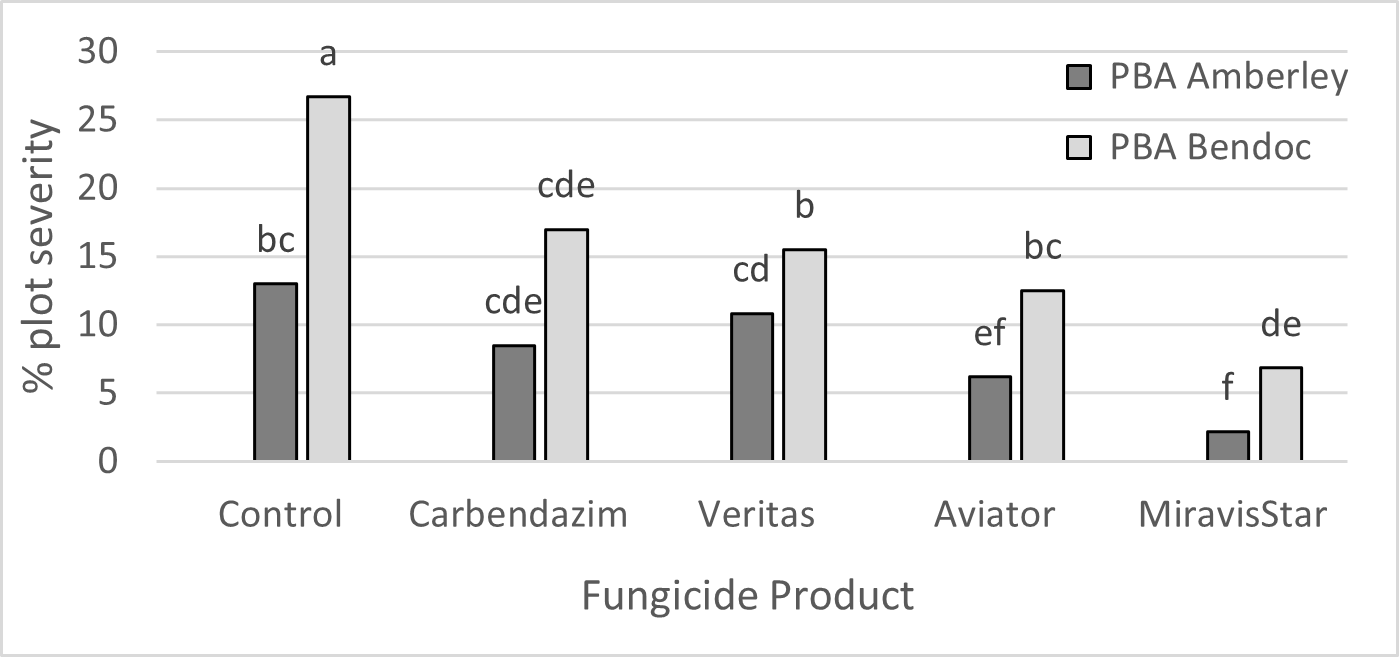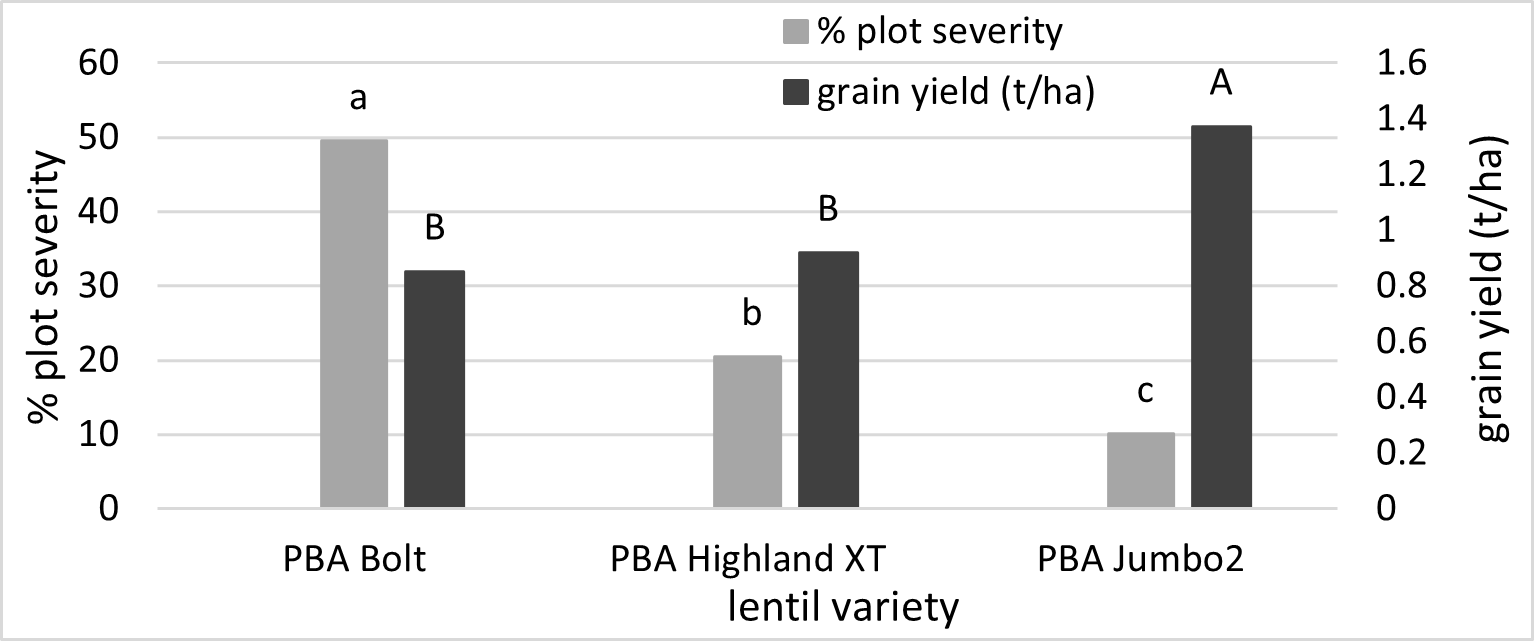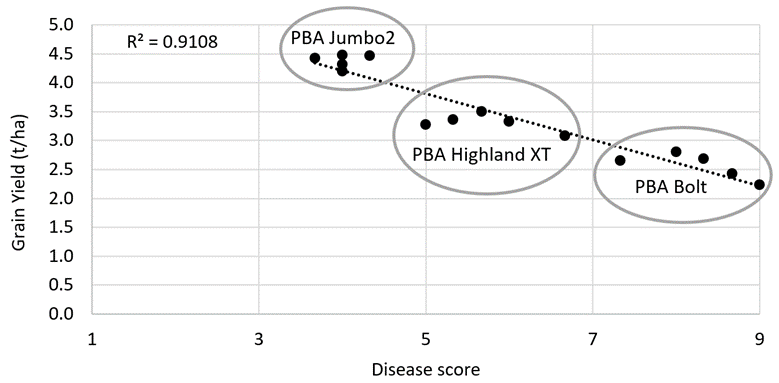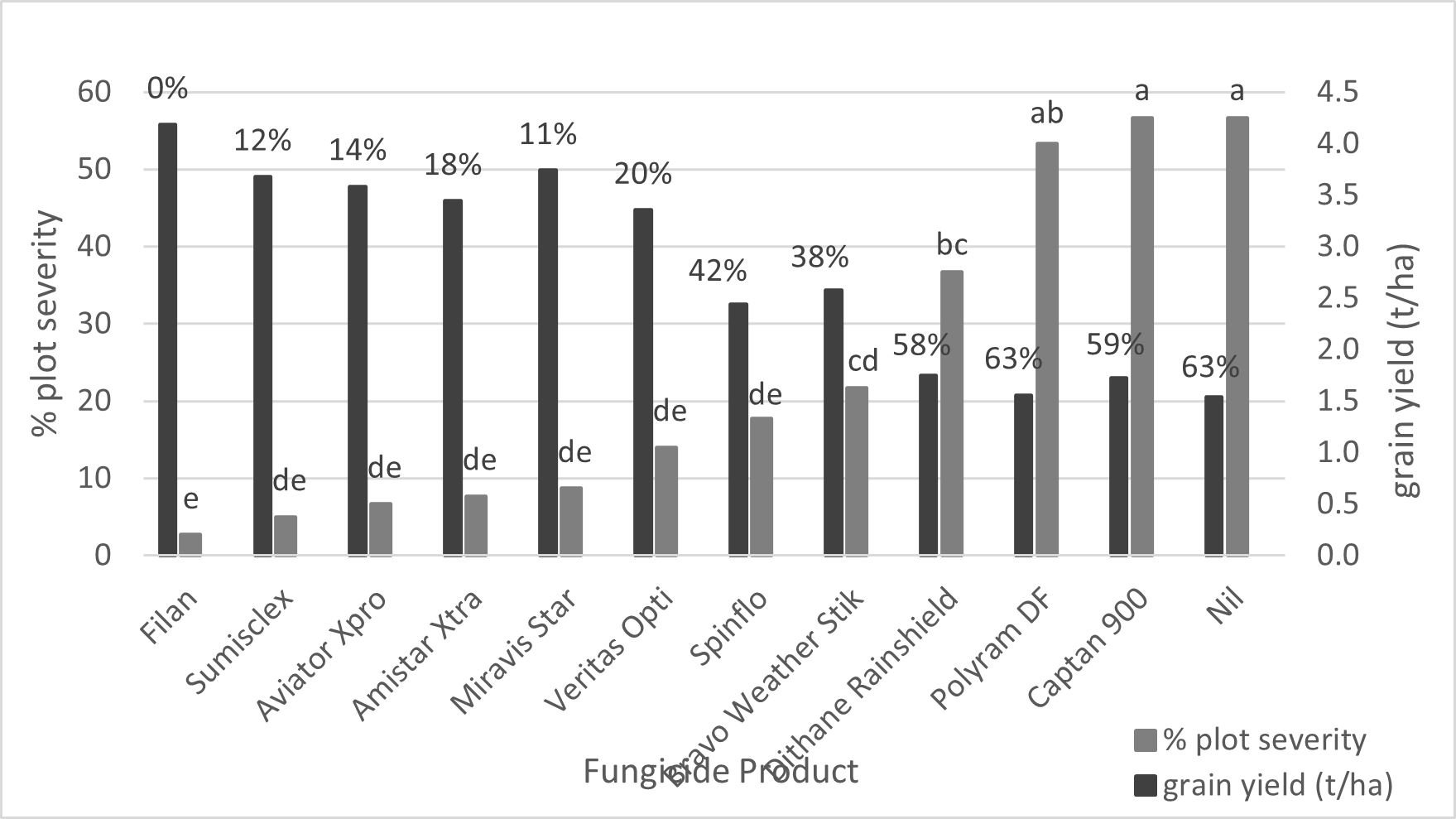2022 Pulse disease wrap up
Take home messages
- 2022 was an exceptional year for pulse foliar disease. Severe chocolate spot (CS) in faba bean, and botrytis grey mould (BGM) and sclerotinia in lentil, was frequently reported and widespread throughout spring.
- The first step to good disease management is choosing a resistant variety.
- Newer fungicides with dual modes of action can provide superior disease control of CS of faba bean and BGM of lentil and may preserve yields in a high disease situation.
- To control brown spot of lupin, the best strategy is to protect the developing seedling.
- Ascochyta blight pathogen populations of lentil and faba bean both require constant scrutiny to monitor for shifts in aggressiveness that place varietal resistance at risk.
- Pre-canopy closure fungicides protect the base of the crop before the canopy closes over. Follow-up sprays ahead of rain events may be required and growers should consider the need for a podding spray if disease is present or if disease risk is high.
- Growers are encouraged to monitor crops for disease. Proactive or pre-emptive fungicide applications ahead of rain events protect the crop from developing severe disease, especially in a wet spring.
Chocolate spot of faba bean
In spring 2022, chocolate spot (CS) of faba bean was reported frequently across South Australia (SA) and observed as aggressive, blackening and rapidly defoliating plants, often within a few days. CS can be easily distinguished from other faba bean leaf diseases as it also infects flowers. The disease is promoted by mild temperatures (15–25⁰C) and high humidity (>70%) persisting over 4–5 days during flowering and after canopy closure. These optimal disease conditions persisted throughout spring and into early summer of 2022, creating an epidemic across the state. Reports of a mistimed spray(s), often due to persistent rain restricting paddock access, were associated with moderate to severe CS disease levels, crop lodging, and sometimes complete crop failure.
Growers are encouraged to be proactive in controlling CS by applying pre-emptive fungicide sprays at early-mid flowering before symptoms appear. Follow-up sprays will be required in high rainfall situations and high biomass crops, especially where there was a high seeding rate and/or early sowing. Humidity can be retained within the canopy and is an ideal environment for CS to proliferate. Areas around trees and under power lines can become hot spots for the disease if spray planes are unable to reach those areas of the crop.
In 2022, a trial was sown at Riverton with PBA Amberley (rated MRMS) and PBA Bendoc (rated S) to compare two strategic applications of four different fungicide products applied prior to and post-canopy closure for general disease management in faba bean (Table 1). A moderate level of Chocolate Spot disease developed in the trial and PBA Amberley recorded significantly less disease than PBA Bendoc across treatments on 19 October (P<0.001). This highlights the importance of varietal resistance in disease management. In this trial, Miravis® Star outperformed the other products (Figure 1). Grain yield ranged from 2.93t/ha to 3.95t/ha in the trial and yields of PBA Amberley were higher than PBA Bendoc across most treatments, however results were influenced by disease level (Table 2).
Table 1: Foliar fungicide products and application timing for faba bean foliar disease management trial at Riverton in 2022.
Fungicide product | Application timing | Trial rate (mL or g product per ha) |
|---|---|---|
Untreated control | N/A | N/A |
Tebuconazole f/b Carbendazim (x2 applications) | 6 weeks post-sowing (07/07/2022) Pre-canopy closure (16/08/2022) Post-canopy closure (05/09/2022) | 350 500 500 |
Veritas® (x2 applications) | Pre-canopy closure (16/08/2022) Post-canopy closure (05/09/2022) | 1000 |
Aviator® XPro® (x2 applications) | Pre-canopy closure (16/08/2022) Post-canopy closure (05/09/2022) | 600 |
Miravis® Star (x2 applications) | Pre-canopy closure (16/08/2022) Post-canopy closure (05/09/2022) | 750 |
f/b = followed by

Figure 1. Chocolate spot severity (0–100% plot disease) on PBA Amberley and PBA Bendoc rated on 19 October 2022 at Riverton. Lowercase letters denote significant differences between treatments and variety where columns are labelled with different letters. Least Significant Difference of means (5% level) = 4.592 (P=0.041).
Table 2: Grain yield (t/ha) of PBA Amberley and PBA Bendoc when treated with strategic applications of four fungicide products at Riverton in 2022. Lowercase letters denote significant differences between treatments and variety. Least Significant Difference of means (5% level) = 0.436 (P=0.032).
Fungicide | PBA Amberley | PBA Bendoc |
|---|---|---|
Untreated control | 3.22 b | 3.16 b |
Carbendazim | 3.19 b | 2.95 b |
Veritas | 3.32 b | 2.95 b |
Aviator Xpro | 3.773 a | 2.93 b |
Miravis Star | 3.95 a | 3.21 b |
Disease surveillance of faba beans
Twenty faba bean crops were surveyed across the Mid North and South East of SA for endemic and notifiable exotic diseases in 2022. Crops were selected with assistance from regional agronomists. Fifty plants per crop were sampled and whole plant per cent disease severity rated. A very high incidence of CS was recorded ranging from 78% to 100% of plants infected in 14 of 20 paddocks surveyed in mid spring and disease severity in affected paddocks ranged from 2% to 52%. Ascochyta blight (AB) was recorded in 8 of 20 paddocks, but at very low level of severity (5% or less). Cercospora leaf spot was also recorded in 13 of 20 paddocks surveyed, ranging from 2% to 100% incidence, with disease severity between <1% to 20%. Rust was only detected in two paddocks in the Mid North at a very low incidence (<1%) and severity (<1%). No sclerotinia or the exotic disease, downy mildew, was observed.
Botrytis grey mould of lentil
Botrytis grey mould (BGM) is favoured by mild temperatures and high humidity, and in spring 2022 the disease was frequently reported and observed as aggressive. Early sowing and/or high seeding rates can create dense canopies and warm humid conditions under the canopy become ideal for rapid disease development. BGM is best controlled initially by a prophylactic foliar spray targeting BGM applied immediately before canopy closure. This is recommended in all regions for all varieties regardless of the resistance rating to protect the base of the crop. Follow-up sprays may be required in medium to high rainfall zones but are unlikely to be needed in low rainfall zones, except in a wet spring. In low rainfall zones, the likelihood of ongoing humid conditions that promote the disease should be considered to ensure application of foliar fungicides are economically warranted.
In 2022, three lentil trials (Riverton, Hart and Maitland) were sown in locations at high risk of developing BGM with the aim of assessing yield loss from disease infection, economics of disease control strategies, disease infection under different crop canopies, or to examine the efficacy of registered or permitted fungicides on BGM. Average BGM per cent (%) plot severity was rated in the Riverton and Maitland trial, whilst at Hart, disease was rated on a 1 (nil disease) to 7 (complete plot loss) scale. Fungicide products and application timings for Riverton and Hart are listed in Table 3, and for Maitland in Table 4.
At Riverton, disease severity was significantly lower in PBA Jumbo2 than PBA HighlandXT and PBA Bolt (P<0.001; Figure 2) which are currently rated RMR, MRMS and S respectively. There was no difference in disease severity between seeding rates (standard 120 plant/sqm vs higher 150 plants/sqm), or use of fungicide product. Grain yield of PBA Jumbo2 was significantly higher (P=0.033) at 1.37t/ha compared to PBA HighlandXT (0.92t/ha) and PBA Bolt (0.85t/ha). The wet spring in 2022 highlights the importance of varietal resistance in disease control and in preserving grain yield.
At Hart, BGM disease severity and grain yield was highly correlated with variety resistance, with PBA Jumbo2 scoring the lowest plot disease rating (P<0.001; Figure 3). Fungicide treatment made no difference to grain yield of the different varieties. This should give growers confidence that in a disease conducive situation, a lentil variety with a high level of BGM resistance will yield well.
At Maitland, 12 fungicides (Table 4) were examined for control of BGM in PBA Ace (rated MS for BGM). A high level of BGM disease developed in spring and disease severity across treatments ranged from 2.7% to 56.7% on 5 October (Figure 4). Disease control was maintained after this rating date through to harvest. Grain yield (t/ha) was highly correlated with per cent disease severity (R2=0.76) and higher yields were recorded in plots with lower levels of disease. Grain yield was highest in the Filan® treatment (4.18t/ha) and lowest in the nil treatment (1.53t/ha). In this trial, newer fungicide chemistries achieved greater grain yield preservation, this included fungicides with dual active ingredients. The only exception was Sumisclex® that performed similarly to the best treatments.
Table 3: Foliar fungicide products and application timing for Botrytis grey mould of lentil fungicide trial at Riverton and Hart in 2022.
Fungicide product | Application timing | Trial rate (mL or g product per ha) |
|---|---|---|
Untreated control | N/A | N/A |
Carbendazim (x2 applications) | Pre-canopy closure (17/08/2022) Post-canopy closure (06/09/2022) | 500 |
Veritas (x2 applications) | Pre-canopy closure (17/08/2022) Post-canopy closure (06/09/2022) | 1000 |
Aviator XPro f/b carbendazim | Pre-canopy closure (17/08/2022) Post-canopy closure (06/09/2022) | 600 500 |
Miravis Star f/b carbendazim | Pre-canopy closure (17/08/2022) Post-canopy closure (06/09/2022) | 750 500 |
f/b = followed by
Table 4: Foliar fungicide products for the Botrytis grey mould of lentil fungicide trial on PBA AceA at Maitland. Products were applied twice at (1) pre-canopy closure on 16 August and (2) post-canopy closure/early flowering on 13 September, before disease was rated on 5 October.
Fungicide product | Fungicide active | Group | Trial rate (mL or g product per ha) |
|---|---|---|---|
Nil | n/a | n/a | |
Dithane® Rainshield | mancozeb | M3 | 2200 |
Spin Flo® | carbendazim | 1 | 500 |
Bravo ® Weather Stik® | chlorothalonil | M5 | 2000 |
Sumisclex® | procymidone | 2 | 500 |
Veritas Opti | tebuconazole + azoxystrobin | 11+3 | 540 |
Amistar® Xtra | azoxystrobin + cyproconazole | 3+11 | 600 |
Aviator Xpro | bixafen + prothioconazole | 7+3 | 600 |
Polyram® DF | metiram | M3 | 2200 |
Captan 900 1 | captan | M4 | 1100 |
Filan ®2 | boscalid | 7 | 600 |
Miravis Star | pydiflumetofen + fludioxonil | 7+12 | 500* |
1Captan is used under permit PER81406.
2Filan is used under permit PER82476.
*Where a rate range is listed on the label, the highest rate was used. However, Miravis Star was unintentionally applied at 500mL/ha, the high label rate for Ascochyta Blight, whereas the label rate range for BGM control is 750–1000mL/ha.

Figure 2. Botrytis grey mould severity (0–100% plot disease) and grain yield (t/ha) for PBA Bolt, PBA HighlandXT and PBA Jumbo2 at Riverton in 2022. Where columns are labelled with different letters: (1) lowercase letters denote significant differences between variety disease severity, Least Significant Difference of means (5% level) = 7.12 (P<0.001); and (2) uppercase letters denote significant differences between variety grain yield, Least Significant Difference of means (5% level) = 0.4227 (P=0.033).

Figure 3. Botrytis grey mould severity (1–9 scale, plot disease) and grain yield (t/ha) for PBA Bolt, PBA HighlandXT and PBA Jumbo2 at Hart in 2022.

Figure 4. Botrytis grey mould severity (0–100% plot disease) rated on 5 October and grain yield (t/ha) for PBA Ace treated with 12 different fungicides applied at Maitland. Lowercase letters denote significant differences in disease severity between treatments; Least Significant Difference of predicted means (5% level) =18.5 (P<0.001). Grain yield loss (%) relative to the highest yielding treatment is also presented.
Ascochyta blight in faba bean and lentil
Annual pathogenicity testing of Ascochyta fabae on faba bean
Pathotype 2 of ascochyta blight (AB) on faba bean is dominant across southern Australia (Blake et al. 2022) and the National Variety Trial disease ratings reflect this shift. A third pathotype, aggressive on PBA Samira, is present at low prevalence in the pathogen population (Blakeet al. 2022). PBA Samira is currently rated RMR to AB, however SARDI’s annual testing of A. fabae isolates on faba bean hosts revealed that 8 of 20 isolates (40%) collected from SA in 2021 caused a higher-than-expected level of disease (Table 4). Of the isolates collected and tested from SA, 18 of 20 (90%) caused a resistant reaction or low level of infection on PBA Amberley and this corresponds to the variety’s current AB rating of RMR. For PBA Bendoc, currently rated MR to AB, all the SA isolates tested were capable of infecting at a low to high level. Therefore, isolates exist in the pathogen population that can overcome the resistance in PBA Bendoc. These isolates may become selected for over time in intensive faba bean cropping systems and presents a risk of resistance ratings being downgraded in the future. Nura remains highly resistant. A similar pattern was observed for isolates collected from Victoria from 2019 to 2021. Continued monitoring remains critical to reveal if any further shifts are occurring in the pathogen population and to deliver aggressive isolates for resistant plant selection in the breeding program. This is particularly important as we see the area and intensity of faba bean production continue to expand.
Table 4: Forty Ascochyta fabae isolates collected from 2019 to 2021 from SA and Vic were inoculated onto a faba bean host differential set in controlled environment conditions in 2022. Entries in the table are the number of isolates per category.
Test reaction | Farah AR | Samira AR | Nura AR | PBA Amberley | PBA Bendoc | |
|---|---|---|---|---|---|---|
Reaction of isolates collected from SA in 2021 (n=20) | R | 0 | 8 | 17 | 9 | 0 |
MR | 0 | 4 | 3 | 9 | 3 | |
MRMS | 0 | 7 | 0 | 2 | 14 | |
MS | 9 | 1 | 0 | 0 | 3 | |
S | 11 | 0 | 0 | 0 | 0 | |
SA Total | 20 | 20 | 20 | 20 | 20 | |
Reaction of isolates collected from Vic in 2019 (n= 11), 2020 (n=5) and 2021 (n=4) combined. | R | 0 | 17 | 20 | 15 | 5 |
MR | 0 | 3 | 0 | 4 | 7 | |
MRMS | 2 | 0 | 0 | 0 | 5 | |
MS | 5 | 0 | 0 | 1 | 3 | |
S | 13 | 0 | 0 | 0 | 0 | |
VIC Total | 20 | 20 | 20 | 20 | 20 |
Note: R = resistant, MR=moderately resistant, MRMS = moderately resistant-moderately susceptible, MS = moderately susceptible; S = susceptible. AR lines are selections made within the breeding program presumed to be fixed for that variety’s source of ascochyta blight resistance.
Annual pathogenicity testing of Ascochyta lentis on lentil
SARDI’s annual controlled environment testing of 24 A. lentis isolates (21 from SA, 3 from Vic) was conducted in 2022 on a lentil differential host set (Table 5). Of the isolates tested, all were capable of infecting PBA Hurricane XT, and 19 of 24 (79%) caused a moderate to high level of disease. PBA Hurricane XT is currently rated MRMS to AB pathotype 2 and should be monitored and managed proactively for AB disease. Eleven of 20 isolates (46%) were capable of infecting PBA HighlandXT so growers should also closely monitor this variety for AB disease.
Table 5: Twenty-four Ascochyta lentis isolates collected in 2021 from SA (n=21) and Vic (n=3) were inoculated onto a lentil host differential set in controlled environment conditions in 2022. Entries in the table are the number of isolates per category.
Test reaction | Cumra (susceptible check) | Nipper | PBA Hurricane XT | PBA HighlandXT | ILL7537 (elite breeding line) |
|---|---|---|---|---|---|
R | 0 | 7 | 0 | 13 | 24 |
MR | 3 | 9 | 5 | 5 | 0 |
MRMS | 6 | 7 | 8 | 5 | 0 |
MS | 8 | 1 | 9 | 1 | 0 |
S | 7 | 0 | 2 | 0 | 0 |
Total | 24 | 24 | 24 | 24 | 24 |
Key: R = resistant, MR = moderately resistant, MRMS - moderately resistant moderately susceptible, MS = moderately susceptible, S = susceptible
Ratings for lentil and faba bean varieties are reviewed annually as part of the NVT disease ratings review and is usually finalised by early March each year. Updated ratings are available from GRDC NVT. Growers are encouraged to monitor for AB and if infection is present, plan to spray ahead of rain fronts. When wet weather persists up to harvest and where AB is present in the crop, stem infection can cause lodging in faba beans. Pod infection can cause seed staining and downgrading of seed quality. Hence, podding sprays may be necessary in a wet spring taking withholding periods and label directions for use into consideration.
Brown spot of lupin
The pathogen Pleiochaeta setosa causes both brown spot and Pleiochaeta root rot of lupin. It often occurs at low levels in many lupin crops across Australia including SA. Inoculum is splashed up from the infected organic matter in the soil, and then splashed from lower leaves to higher leaves. Infection can be worse in high rainfall situations. The disease can affect pods and cause yield loss and reduced seed quality.
As no foliar fungicides are registered for control of brown spot in lupin, the best strategy is to protect emerging seedlings. Control strategies include:
- slashing stubble from the previous cereal crop to lie on top of the soil as a physical barrier to soil borne spores splashing up onto plants
- use fungicide seed dressings containing iprodione or procymidone to protect against seedling infection
- minimum of 3 years rotation between lupin crops.
For more information on brown spot access the AGRIC website
Conclusion
Choosing a variety with good disease resistance is the first choice a grower can make to preserve grain yield. A minimum of three years rotation between the same crop and same variety is another straightforward choice to help reduce the risk of most pulse foliar diseases. To control brown spot of lupin, the best strategy is to protect the developing seedling by leaving slashed stubble on the soil and using a seed treatment. Where fungicides are recommended or required, ensure they are applied ahead of a rain event. Pre-canopy closure fungicides help protect the base of the crop before the canopy closes over, as fungicides cannot effectively penetrate the canopy after this stage. If the disease risk is high, especially in a wet spring, apply proactive or pre-emptive fungicide applications, consider follow-up sprays and the need for a podding spray to protect the developing grain. Growers are encouraged to monitor crops for disease and report observations to their agronomist or state pathologist.
Disease samples of ascochyta blight and sclerotinia sought
Diseased samples of pulses with ascochyta blight or sclerotinia are sought by SARDI for GRDC-investment projects monitoring pathogen populations and changes in varietal resistance. If you can help, please contact Sara Blake (email: sara.blake@sa.gov.au) for a collection kit that includes sample envelopes and a return Express Post envelope.
Diagnostic plant samples can be sent by Express Post to Pulse Pathology Plant Diagnostics SARDI, Locked Bag 100, Glen Osmond, 5064. Dig up whole symptomatic and asymptomatic plants and send with roots wrapped in damp (not wet) paper towel. Send at the beginning of the week, so the parcel does not get held up in the post. Send an email to PIRSA.SARDIPulsepathology@sa.gov.au to notify the team that the plants are coming.
Crop protection products
There are often changes to permits for the use of fungicides in pulse crops. See Pulse Australia’s website (www.pulseaus.com.au) or APVMA’s website (www.apvma.gov.au) for current information on Crop Protection Products including Minor Use Permits.
Acknowledgements
The research undertaken as part of these projects is made possible by the significant contributions of growers through both trial cooperation and the support of the GRDC, the authors would like to thank them for their continued support. The continued technical assistance from SARDI Clare Agronomy, SARDI Pulse Pathology, and the University of Adelaide faba bean breeding program is gratefully acknowledged. Agriculture Victoria also supplied some of the Ascochyta spp. isolates, thank you. The assistance of regional agronomists and growers in conducting the crop survey is greatly appreciated.
References
Blake SN, Lee RC, Russ MH, Farquharson EA, Rose JA, Herdina, Goonetilleke SN, Farfan-Caceres LM, Debler JW, Syme RA, Davidson JA (2022) Phenotypic and genotypic diversity of Ascochyta fabae populations in southern Australia. Frontiers in Plant Science 13, 918211. doi: 10.3389/fpls.2022.918211
Seasonal disease reports – subscribe to SA Crop Watch e-newsletter
Lentil Southern Region GrowNotes™
Faba Bean Southern Region GrowNotes™
Field Pea Southern Region GrowNotes™
Lupin Southern Region GrowNotes™
Vetch Southern Region GrowNotes™
Chickpea Southern Region GrowNotes™
South Australian Crop Sowing Guide
Contact details
Sara Blake
GPO Box 397, Adelaide SA 5001
8429 2248
sara.blake@sa.gov.au
@Sara_N_Blake
GRDC Project Code: UOA2105-013RTX, UOA2104-012RTX, CUR1403-002BLX, UOA1606-009RTX,
Was this page helpful?
YOUR FEEDBACK
